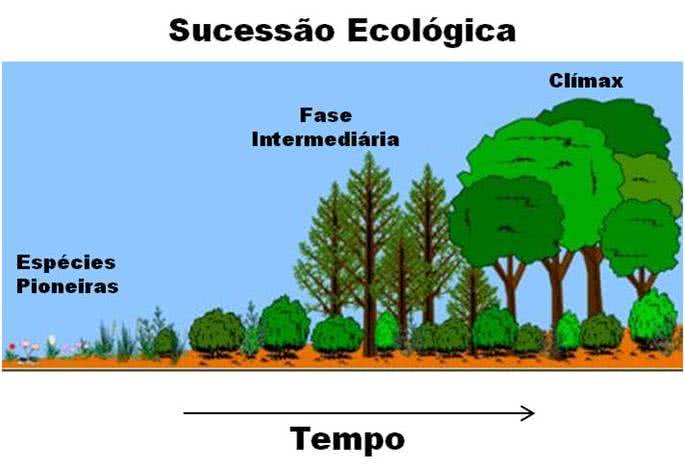Ecological succession is the gradual process of changing the structure and composition of a community.
It represents an ordered process of changes in the ecosystem, including changes in the physical environment by the biological community, until reaching the climax phase.
During ecological succession, the simplest communities will over time be replaced by more complex communities.
Ecological succession goes through three phases: ecesis , seral and climax .
Ecese represents the pioneer community. They are the first organisms to settle in the environment, such as lichens, grasses and insects.
Seral is the intermediate community. Represented by small, shrub and herbaceous vegetation. In this phase there are significant changes in the community.
The last phase is the climax, the stabilized community. The community reaches a high number of species, ecological niches are occupied and has a large amount of biomass.
The community tends to evolve to a climax, when it is formed by populations in balance with the environment.

Autogenic succession and Allogeneic succession
Depending on the forces driving the process, the succession can be of the following types:
- Autogenic Succession : caused by changes caused by biological processes internal to the ecosystem.
- Allogeneic Succession : when changes occur due to forces external to the ecosystem, such as storms, fires and geological processes.
Types of Ecological Succession
The ecological succession can be classified according to the nature of the substrate that gives rise to the process in: primary succession and secondary succession.
Primary Succession
Primary succession begins in an uninhabited area.
It occurs in environments that were not previously occupied by living beings, such as bare rocks, solidified lava, sand deposits, a recent strip of beach.
The first organisms to set up are called pioneers.
The pioneer species can settle in inhospitable places, subject to various environmental conditions and pave the way for the establishment of new species.
Lichens and grasses are examples of pioneer species.
The colonization of pioneer species is important for the succession process. From the pioneers, the original conditions of the environment begin to change.
As an example, the vegetation cover of pioneer plant species reduces sudden changes in soil temperature and contributes to its stabilization. These conditions favor the arrival of new species to populate the community.
Primary succession is a slow process. A rocky soil can take decades to shelter vegetation of shrubs and herbs.
Secondary Succession
Secondary succession occurs on substrates that were previously occupied by a biological community. Therefore, they present more conditions for the establishment of living beings.
As an example are clearings, deforested areas and abandoned farming fields.
The secondary succession develops more quickly than the primary.
One reason is that some organisms and seeds can remain in the soil, making the substrate more favorable to recolonization by other living beings.
Exercises
(UFSCar) – The orderly and gradual replacement of one community by another, until a stable community is reached, is called ecological succession. In this process, it can be said that what happens is
a) the constancy of biomass and species
b) the reduction of biomass and greater diversification of species
c) the reduction of biomass and less diversification of species
d) the increase in biomass and less diversification of species
e) the increase in biomass and greater species diversification
Answer
e) the increase in biomass and greater diversification of species
(UNESP) – Consider the statements:
1. Ecological succession is the name given to the process of gradual changes in the constitution of communities of organisms.
2. When a succession stage is reached, the corresponding community is the climax community.
3. In an ecological succession, species diversity increases initially, reaching the highest point in the climax and then stabilizing.
4. In an ecological succession there is an increase in biomass. Please tick:
a) if all statements are incorrect;
b) if all statements are correct;
c) if only statements 1 and 4 are correct;
d) if only statements 1 and 4 are incorrect;
e) if only statement 4 is correct.
Answer
b) if all statements are correct;
(UFJF) Fires, common in the dry season in several Brazilian regions, can cause the destruction of natural vegetation. After the occurrence of fires in a forest, it is CORRECT to state that:
a) over time, primary succession will occur.
b) after the establishment of the lichens, new species will be installed.
c) the climax community will be the first to recover.
d) it is only after the animals return that the plants will return to settle in the burned area.
e) colonization by pioneer species will facilitate the establishment of other species.
Answer
e) colonization by pioneer species will facilitate the establishment of other species.
